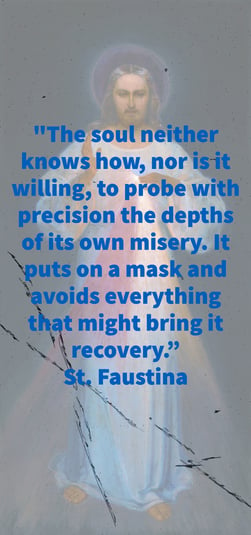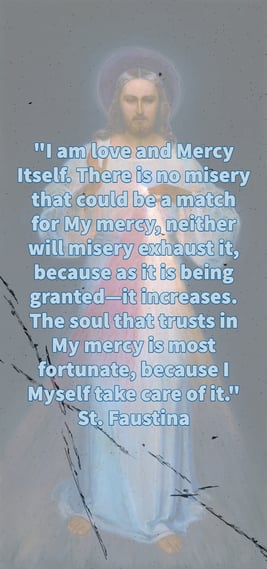The struggle within is one of the most connective aspects of the human experience—it is something we cannot outrun. However, amid the madness of life, God has given us a way to heal and overcome: divine mercy.
Saint Faustina, the Patron Saint of Divine Mercy, used her life for the mission He gave her and continues to inspire us. As the “Apostle of Mercy,” she was appointed to help save us—sinners—from the chasms of hell. Her diary, which she kept throughout the Nazi occupation of Poland, reminds us of the power of His mercy and ours.
The Journey to Become Sister Maria Faustina Kowalska
Born as Helena Kowalska, Saint Faustina was born in Glogoweic, Poland, on August 25, 1905. She was the third eldest of ten children in a family that was religious but poor.
At the young age of seven, Faustina first felt a calling to religious life while attending the Exposition of the Blessed Sacrament. When she completed her primary schooling, she asked her parents if she could go join a convent—they refused. Instead, at 16, she started providing income for the family and herself as a housekeeper.
While attending a dance with her sister Natalia, Faustina saw Jesus for the first time. After seeing the suffering Jesus, she went straight to a Cathedral where He spoke to her, instructing her to go to Warsaw, Poland, and join a convent. The next morning, her bags were packed, and she headed to Warsaw.

Upon arriving, she entered the first church she saw—Saint James Church—and attended Mass. Faustina then began seeking out different convents, asking permission to join. She was continuously denied her request because her appearance depicted poverty.
Eventually, though, she went to the Congregation of the Sisters of Our Lady of Mercy, where the mother superior allowed her request so long as she paid her way. Faustina continued to work as a housekeeper to pay for her religious habit. On April 30, 1926 (at the age of twenty), she finally received her habit. She took her religious vows in 1928 and was then given her religious name: Sister Maria Faustina of the Blessed Sacrament.
St. Faustina’s Vision of Hell
On October 20, 1936, Faustina began an eight-day retreat, and during this retreat, she was greeted by an angel. This angel led her to what it called “the chasms of Hell”— a place that Faustina notes in her diary as filled with darkness, terrible suffering, and great torture. Faustina also notes that even though it was full of great darkness, the inhabitants could still see each other and all the evil.
Faustina also describes the “chasms of Hell” as having special levels reserved for unique punishments earned while in the living world—similar to those of Dante’s Inferno. Like Dante’s “contrapasso,” Faustina writes in her diary that “these are the torments of the senses. Each soul undergoes terrible and indescribable sufferings related to the manner in which it has sinned.”
The Torture Levels of Hell, according to Faustina’s Vision, are as follows, but we must note that these levels are not where the suffering ends:
- The First Torture is the loss of God.
- The Second Torture is the perpetual remorse of conscience.
- The Third Torture is that the individual’s condition will never change.
- The Fourth Torture is that a fire will enter the soul without killing it—a spiritual fire that comes from God’s anger.
- The Fifth Torture is a continual darkness and foul smell where only the devils and the souls of the damned can see each other.
- The Sixth Torture is in endless company with Satan.
- The Seventh Torture consists of hatred of God, deep despair, blasphemies, and curses.
Faustina says that she only saw shadows of Hell, but that one thing was completely clear: those who were in the chasms of Hell were those who did not believe in Hell.

A St. Faustina Miracle That Led to Her Beautification
Maureen Digan, at the young age of 15, was diagnosed with lymphedema (a terminal disease that progresses slowly). The severe condition cannot be treated with medications, nor does it enter into remission. By the time Maureen reached the age of 25, she had undergone fifty operations and spent an enormous amount of time in the hospital—one time, even up to a year!
The loved ones that surrounded Maureen encouraged her to pray and lift her tribulations up to God. However, Maureen found it hard to understand why an all-loving God would allow her to go through so much suffering. Consequently, she lost her faith in Him. Soon, she was told that she would have to amputate one of her legs.
One night, during one of Maureen’s long hospital stays, her husband Bob watched a documentary on Divine Mercy. It was then that he became convinced that his wife needed the healing powers of intercession by Sr. Maria Faustina. He convinced Maureen—and her doctors—that she needed to go to Poland to visit her tomb.
On March 23, 1981, they arrived in Poland, and Maureen attended Confession for the first time since she was young.

When they visited the Shrine of The Divine Mercy outside Krakow, Poland, Maureen recalls saying, "Okay, Faustina, I came a long way; now do something." She then heard Sr. Faustina say: "If you ask for my help, I will give it to you." Her pain then flowed from her body, and her leg—the one that was deemed to be amputated—returned to its normal size.
After returning to America, Maureen was examined by five different doctors. All the doctors agreed that she was suddenly healed of the incurable and untreatable disease. The miraculous healing was then examined by five doctors appointed by the Sacred Congregation for the Causes of Saints. After the doctors concluded the healing beyond scientific explanation, a team of theologians, followed by a team of cardinals and bishops, also investigated the healing. The cure was soon accepted as a miracle, and Sr. Faustina was beatified on April 18, 1993, and canonized on April 30, 2000.
St. Faustina Quotes and What We Can Learn from Them
Saints often leave us with quotes that can be applied in our daily lives and faith—St. Faustina is no different. Below are some quotes and their lessons.
St. Faustina Quote 1:
“Proclaim that mercy is the greatest attribute of God. All the works of My hands are crowned with mercy.”
It is in this quote that we find the heart of St. Faustina’s message: Divine Mercy. It is common in our social-media-saturated culture today to pose ourselves as always our best. But this is not the full reality. While we may be able to hide our “bad side” and faults from those around us—through a screen or in person—we can not do so from God. He is an all-loving God. He sees our everything. It is through His Divine Mercy that we are healed and saved. So, go to Him in all your troubles, failures, and heartbreaks, and seek the mercy that only He can give.
St. Faustina Quote 2:
“My daughter, have fear of nothing; I am always with you. All your adversaries will harm you only to the degree that I permit them to do so. You are my dwelling place and my constant repose. For your sake I will withhold the hand which punishes; for your sake I bless the earth.”
Our human life is littered with many trials and tribulations. We struggle with our enemies. We struggle with money. We struggle with natural disasters. We struggle with political agendas. We struggle to keep religion at the forefront. However, despite all these struggles (and more that are not listed), we must remember this: God has already been victorious and will never relinquish His control.
St. Faustina Quote 3:
“Then I heard the words, ‘I am glad you behaved like My true daughter. Be always merciful as I am merciful. Love everyone out of love for Me, even your greatest enemies, so that My mercy may be fully reflected in your heart.”
A common human experience is that of conflict. It could be a friend that wronged you. It could be an enemy continuously confronting you and/or your morals. It could be a person who greatly caused you harm. No matter the struggle you are facing with other individuals, it is still an opportunity for you to extend mercy to them. This could be done through prayer or forgiveness, but however you give mercy, it is one of the most beautiful and powerful things you could do.
St. Faustina Quote 4:
“When once I asked the Lord Jesus how He could tolerate so many sins and crimes and not punish them, the Lord answered me, ‘I have an eternity for punishing [these], and so I am prolonging the time of mercy for the sake of [sinners]. But woe to them if they do not recognize the time of My visitation.”
We are constantly presented with the ability to turn our eyes and hearts toward God. In fact, the vast amount of opportunities for mercy that He extends to us is truly breathtaking! It is incredibly important that every day and through every breath He blesses us with, we constantly reach our hand out and grasp every opportunity he lays before us.
Prayer to St. Faustina by Saint John Paul II
And you, Faustina, a gift of God to our time, a gift from the land of Poland to the whole Church, obtain for us an awareness of the depth of Divine Mercy; help us to have a living experience of it and to bear witness to it among our brothers and sisters. May your message of light and hope spread throughout the world, spurring sinners to conversion, calming rivalries and hatred, and opening individuals and nations to the practice of brotherhood. Today, fixing our gaze with you on the Face of the Risen Christ, let us make our own your prayer of trusting abandonment and say with firm hope:” Jesus, I trust in You!”
—St. John Paul II, Rome, April 30, 2000
*Originally published November 18, 2022.

